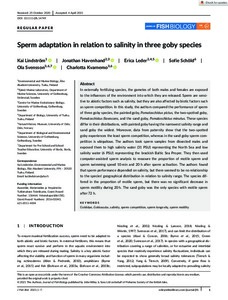Sperm adaptation in relation to salinity in three goby species
Lindström Kai; Havenhand Jonathan; Leder Erica; Schöld Sofie; Svensson Ola; Kvarnemo Charlotta
Sperm adaptation in relation to salinity in three goby species
Lindström Kai
Havenhand Jonathan
Leder Erica
Schöld Sofie
Svensson Ola
Kvarnemo Charlotta
WILEY
Julkaisun pysyvä osoite on:
https://urn.fi/URN:NBN:fi-fe2021093048149
https://urn.fi/URN:NBN:fi-fe2021093048149
Tiivistelmä
In externally fertilizing species, the gametes of both males and females are exposed to the influences of the environment into which they are released. Sperm are sensitive to abiotic factors such as salinity, but they are also affected by biotic factors such as sperm competition. In this study, the authors compared the performance of sperm of three goby species, the painted goby, Pomatoschistus pictus, the two-spotted goby, Pomatoschistus flavescens, and the sand goby, Pomatoschistus minutus. These species differ in their distributions, with painted goby having the narrowest salinity range and sand goby the widest. Moreover, data from paternity show that the two-spotted goby experiences the least sperm competition, whereas in the sand goby sperm competition is ubiquitous. The authors took sperm samples from dissected males and exposed them to high salinity water (31 PSU) representing the North Sea and low salinity water (6 PSU) representing the brackish Baltic Sea Proper. They then used computer-assisted sperm analysis to measure the proportion of motile sperm and sperm swimming speed 10 min and 20 h after sperm activation. The authors found that sperm performance depended on salinity, but there seemed to be no relationship to the species' geographical distribution in relation to salinity range. The species differed in the proportion of motile sperm, but there was no significant decrease in sperm motility during 20 h. The sand goby was the only species with motile sperm after 72 h.
Kokoelmat
- Rinnakkaistallenteet [27094]
